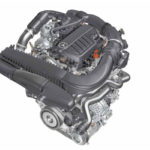In 1993, the 4-cylinder Mercedes M111 E18 engine replaced the E18 engine from the M102 series. Compared to its predecessor, the engine has become more compact, but the block is also made of cast iron, and the cylinder head is made of light alloy metal. According to the owners, this engine is one of the most common and successful models from Mercedes.
R4 Mercedes engines: M102, M111 E18, M111 E20, M111 E22, M111 E23, M166, M254, M260, M264, M266, M270, M271, M274, M282.
Specifications
| Production years | 1993-2000 |
| Displacement, cc | 1799 |
| Fuel system | injector |
| Power output, hp | 122 |
| Torque output, Nm | 170 |
| Cylinder block | cast iron R4 |
| Block head | aluminum 16v |
| Cylinder bore, mm | 85.3 |
| Piston stroke, mm | 78.7 |
| Compression ratio | 9.8 |
| Features | no |
| Hydraulic lifters | yes |
| Timing drive | chain |
| Phase regulator | at the intake |
| Turbocharging | no |
| Recommended engine oil | 5W-40 |
| Engine oil capacity, liter | 5.5 |
| Fuel type | petrol |
| Euro standards | EURO 2/3 |
| Fuel consumption, L/100 km (for C180 W202) — city — highway — combined |
12.7 7.2 8.5 |
| Engine lifespan, km | ~400 000 |
| Weight, kg | 167 |
Disadvantages of the M111 E18 engine
- Most of all, grease leaks will cause you problems, and their number grows with mileage.
- The mass air flow sensor has a modest resource; if it breaks, fuel consumption increases.
- Up to 100,000 kilometers, the water pump almost always starts to leak in the engine.
- From 100 to 200 thousand km, piston skirts often wear out or the exhaust cracks.
- After 200 – 250 thousand km, the oil pump or timing chain drive already requires attention.






